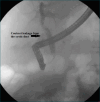Endoscopic management of cystic stump leaks: Insights from a tertiary care center
- PMID: 40765191
- PMCID: PMC12363144
- DOI: 10.14744/tjtes.2025.63221
Endoscopic management of cystic stump leaks: Insights from a tertiary care center
Abstract
Background: Cystic stump leakage is the most common cause of bile leakage following cholecystectomy, representing a significant postoperative complication that requires prompt intervention. Currently, endoscopic treatment is the preferred management approach. This study aims to identify factors influencing the success of endoscopic therapy for cystic stump leaks by analyzing cases treated at our institution.
Methods: Thirty-seven patients who underwent endoscopic retrograde cholangiopancreatography (ERCP) for cystic stump leakage were included in this study. Patient demographics, associated complications, and length of hospital stay were analyzed.
Results: All patients showed clinical improvement, with a mean hospital stay of 5.1 days. The presence of comorbidities, emergency surgery, or conversion to open surgery did not significantly impact treatment efficacy. Post-procedure, percutaneous drainage was required in 10 patients (27%). Procedure-related pancreatitis was noted in one patient (2.7%). Statistical analysis revealed that both the need for percutaneous drainage and the length of hospital stay were significantly lower in patients who had pre-existing drains (p<0.03). Additionally, early ERCP was associated with a significantly shorter hospital stay (p<0.01).
Conclusion: Stent placement via ERCP is a safe and effective strategy for managing cystic stump leaks. Early ERCP intervention following cystic stump leak detection is recommended. Furthermore, percutaneous drainage may be necessary in patients who do not respond adequately to initial treatment.
Conflict of interest statement
Figures
Similar articles
-
NIH state-of-the-science statement on endoscopic retrograde cholangiopancreatography (ERCP) for diagnosis and therapy.NIH Consens State Sci Statements. 2002 Jan 14-16;19(1):1-26. NIH Consens State Sci Statements. 2002. PMID: 14768653
-
Surgical versus endoscopic treatment of bile duct stones.Cochrane Database Syst Rev. 2013 Sep 3;(9):CD003327. doi: 10.1002/14651858.CD003327.pub3. Cochrane Database Syst Rev. 2013. Update in: Cochrane Database Syst Rev. 2013 Dec 12;(12):CD003327. doi: 10.1002/14651858.CD003327.pub4. PMID: 23999986 Updated.
-
Surgical versus endoscopic treatment of bile duct stones.Cochrane Database Syst Rev. 2013 Dec 12;2013(12):CD003327. doi: 10.1002/14651858.CD003327.pub4. Cochrane Database Syst Rev. 2013. PMID: 24338858 Free PMC article.
-
Endoscopic retrograde cholangiopancreatography versus intraoperative cholangiography for diagnosis of common bile duct stones.Cochrane Database Syst Rev. 2015 Feb 26;2015(2):CD010339. doi: 10.1002/14651858.CD010339.pub2. Cochrane Database Syst Rev. 2015. PMID: 25719222 Free PMC article.
-
Prescription of Controlled Substances: Benefits and Risks.2025 Jul 6. In: StatPearls [Internet]. Treasure Island (FL): StatPearls Publishing; 2025 Jan–. 2025 Jul 6. In: StatPearls [Internet]. Treasure Island (FL): StatPearls Publishing; 2025 Jan–. PMID: 30726003 Free Books & Documents.
References
-
- Freiherr G. Biliary lithotripsy. Chicago: Year Book Med Publ; 1989. Gallstones:Statistical considerations; pp. 139–40.
-
- Alexander HC, Bartlett AS, Wells CI, Hannam JA, Moore MR, Poole GH, et al. Reporting of complications after laparoscopic cholecystectomy:A systematic review. HPB. 2018;20:786–94. - PubMed
-
- Barkun AN, Rezieg M, Mehta SN, Pavone E, Landry S, Barkun JS, et al. Postcholecystectomy biliary leaks in the laparoscopic era:Risk factors, presentation, and management. McGill Gallstone Treatment Group. Gastrointest Endosc. 1997;45:277–82. - PubMed
-
- Manguso N, Zuckerman R. Identification and management of bile duct injuries. Surg Clin North Am. 2024;104:1229–36. - PubMed
MeSH terms
LinkOut - more resources
Full Text Sources
Medical


